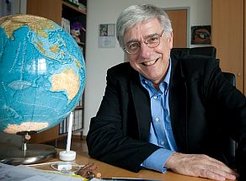Mid- and high-latitude northern hemisphere continues to absorb atmospheric carbon dioxide
The land vegetation and the oceans in Northern extratropical latitudes absorb from the atmosphere about a quarter of the CO2 which is emitted from anthropogenic sources. International carbon cycle experts met at Max Planck Institute for Biogeochemistry in Jena to discuss the scientific background of this process, its stability, new developments and future trends during a 3-day symposium in honor of Prof. Martin Heimann’s retirement as Max Planck director.

The sink function of the Northern hemisphere relies on both the vegetation of the land surface and the oceans.
Vegetation incorporates CO2 through photosynthesis and this uptake increases with higher CO2 concentrations, an effect known as CO2 fertilization. However, this process is also modified by the availability of water and nutrients. Furthermore, changes in land management, in particular regrowing forests in northern mid-latitudes contribute also to the CO2 uptake by the land vegetation. Conversely, rising temperatures enhance soil respiration which reduces the net CO22 absorption. In addition, high-latitude warming fostering permafrost thawing will particularly enhance emissions of CO2 and methane, both powerful greenhouse gases. While the latter high-latitude fluxes are currently still very small, they are expected to accelerate with increased warming in the Arctic, thus constituting an important positive climate feedback.
While many of these complex land processes are still poorly known, powerful research tools have been developed over the last decades providing a much clearer understanding of individual causal links. Among these are high resolution analyses from satellite observations, global inventories using radiocarbon as well as substantial improvements in terrestrial biosphere models including comprehensive descriptions of nutrient and water cycles.
The ocean sink for CO2 has also substantially increased in the last decades as documented by an impressive array of new observation platforms, including automated measurements on ferries and freighter ships, autonomous floating devices and depth profile moorings. These new methodological advances provide a much richer knowledge of ocean carbon cycling than heretofore possible. Of particular interest is the tantalizing finding, that the ocean sink, while increasing, also exhibits much stronger decadal variability than previously thought.
Given the enhanced view of the complex carbon cycle processes on land and in the ocean, it is remarkable that overall the global CO2 sink has remained rather stable so far, at least on decadal average. On shorter time scales, however, interannual variability driven by climate fluctuations, such as the El Niño events is clearly visible in the observations. It is still an open question, whether these short term variations can be taken as an analogue for understanding and quantifying the response of the global carbon cycle to the longer-term global warming expected during this century.
A tribute to Prof. Martin Heimann as an outstanding climate researcher
The scientific symposium on the Northern hemisphere sink was dedicated to Prof. M. Heimann, who retired as Max-Planck director at Max Planck Institute for Biogeochemistry, to honor his seminal role in the research field. As a physicist specializing in atmospheric greenhouse gases, he pioneered comprehensive global climate models, established networks of defined atmospheric measurement stations, substantially improved high-precision and isotopic measurement procedures, and co-initiated the European ICOS network. Prof. Heimann’s influential role was honored in the symposium lectures of the international experts, many of whom he mentored during his fruitful career.
Following his PhD at University of Bern, Switzerland, Prof. Heimann worked as research assistant with Charles D. Keeling at Scripps Institution of Oceanography, UCSD, La Jolla, U.S.A. He proceeded to become a group leader first at the Max Planck Institute for Meteorology, Hamburg, and later at the Max Planck Institute for Biogeochemistry in Jena, where he was promoted Max Planck Director of the Department Biogeochemical Systems in 2003. M. Heimann was elected member of the Academia Europaea and Academician of the International Eurasian Academy of Sciences, received the medal of A.M. Obukhov Institute of Atmospheric Physics at the Russian Academy of Sciences, accepted an honorary professorship at Friedrich-Schiller University Jena, was awarded the Heinrich-Greinacher-Preis and contributed to the Nobel Peace Prize for IPCC in 2007. M. Heimann is now looking forward to continue his successful research as Emeritus Director at MPI-BGC and visiting professor at University of Helsinki, Finland.
